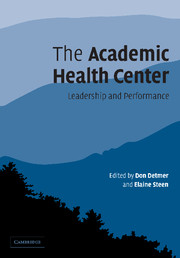Book contents
- Frontmatter
- Contents
- List of figures
- List of tables
- Foreword
- Acknowledgments
- List of contributors
- Introduction
- 1 Academic health centers: current status, future challenges
- 2 A health system for the twenty-first century
- 3 Stronger leadership in and by academic health centers
- 4 Pursuing organizational and cultural change
- 5 Managing and leveraging organizational knowledge
- 6 e-Health challenges and opportunities
- 7 Organizational challenges facing the European academic health center
- Index
- References
2 - A health system for the twenty-first century
Published online by Cambridge University Press: 12 November 2009
- Frontmatter
- Contents
- List of figures
- List of tables
- Foreword
- Acknowledgments
- List of contributors
- Introduction
- 1 Academic health centers: current status, future challenges
- 2 A health system for the twenty-first century
- 3 Stronger leadership in and by academic health centers
- 4 Pursuing organizational and cultural change
- 5 Managing and leveraging organizational knowledge
- 6 e-Health challenges and opportunities
- 7 Organizational challenges facing the European academic health center
- Index
- References
Summary
Introduction
Health care spending in the United States is massive and on the rise. We do not, however, spend our health care dollars wisely. Despite the importance of health and health care to individual, community, and national productivity, we have not designed a health system that assiduously leverages its resources to maximize health. Rather, we continue to support a health care system that does not provide access to basic care for all citizens and does not fully exploit either established knowledge or technologies proven to improve health.
Our health care spending and policy is heavily skewed towards treating rather than preventing illness (leading to higher treatment costs). We overemphasize the care of individuals to the detriment of the health of populations. We do not organize our practice systems to manage chronic illnesses as well as we could. Quality and safety of care are highly variable; both over-treatment and under-treatment are commonplace. Such practices waste dollars and patient time and expose patients to unnecessary risk. Typically, incentives are not aligned with desired behaviors of patients and health professionals. Further, administrative costs are high and regulations are often beside the mark. In short, we must make substantial reforms.
The Blue Ridge Academic Health Group (Blue Ridge Group) believes that it is both possible and essential for the United States to spend its health care dollars much more rationally and effectively. We can build a true health system that is capable of maximizing the health of individuals and populations.
- Type
- Chapter
- Information
- The Academic Health CenterLeadership and Performance, pp. 26 - 72Publisher: Cambridge University PressPrint publication year: 2005



